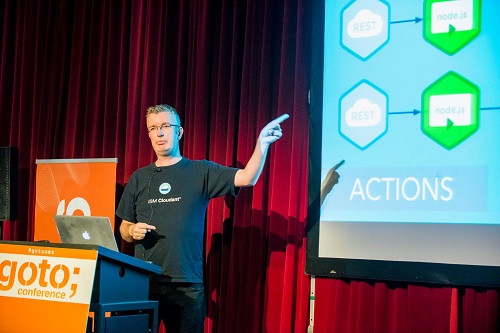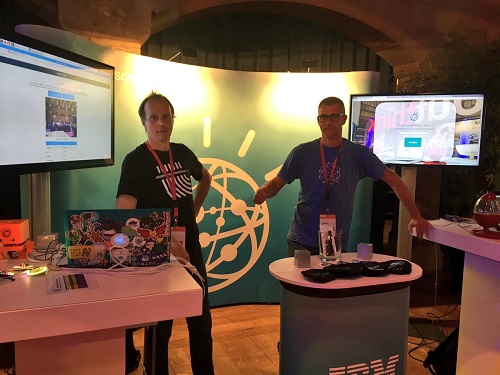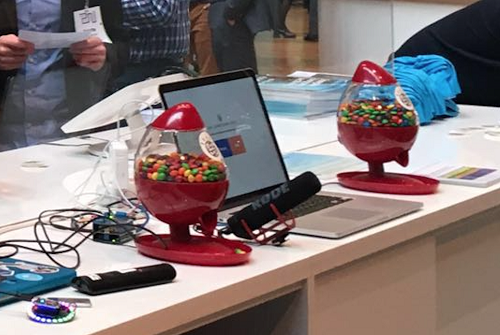Generic
Cardboard robots, happy candy machines, GOTO Amsterdam!
Share this post:
GOTO is a conference for developers from developers. It’s the best meeting place for innovators and thought leaders, and so IBM’s developer advocates were present too. Here’s a short recap for those who couldn’t attend.
IBM supported GOTO Amsterdam with a booth and a speaker slot. The latter turned out to be quite thought provoking, claiming that servers are killing productivity. Glynn Bird, developer advocate for IBM’s Watson data platform, used this afternoon session to point out how developers end up constantly being distracted by maintaining computers. Something the cloud is supposed to fix, but doesn’t always do.

Serverless
He showed developers how to build microservices without servers, with serverless cloud platforms using chatbots, Alexa skills and web form handlers as examples. Such serverless technology, including the open source project Apache OpenWhiskTM, brings significant value. Amongst the benefits are auto-scaling, the handling of inconsistent traffic flows, and resiliency through applications that run isolated. Also, developers pay only for the compute used. Glynn pointed out how these features enable developers to focus on code and innovation instead of managing an infrastructure.
Reading Twitter
Meanwhile at the IBM booth, it was surprising to discover how many visitors were totally unfamiliar with Watson. The demos impressed them especially since they use off the shelf cognitive computing that’s available for free to developers. There was a Watson Analytics demo to show developers how to master the art of data science via IBM’s data science platform. The Watson Tone Analyser, which uses linguistic analysis to detect tones from written text (in this demo we used Twitter messages). The Tone Analyser put tweets that share a tone into the same group. To do this it distinguishes between emotions, social tendencies, and writing style in any text. Tone Analyser will detect five social aspects, derived from the ‘big 5’ personality model. Impressive stuff.

Cardboard cognitive tech
TJ Bot, a DIY cardboard robot powered by Watson, turned out to be a favourite amongst visitors. It’s an open source project, meaning you can build it yourself using instructions on GitHub, although IBM hopes that developers will contribute their own instructions. TJ Bot also responded to emotion on Twitter but in a far more playful way. It followed a hashtag on Twitter and its LED light changed colour based on the public sentiment in that topic. Visitors could also use voice commands, for example by telling it to turn the light red. And it recognised objects held in front of the camera. TJ Bot shows just how inexpensive and accessible cognitive technology has become – either you put it in a cardboard robot for fun or you embed artificial intelligence into everyday stuff like furniture or appliances.

Candy feelings
And of course there was the famous candy machine with feelings. The poor, sensitive little machine reacted to the way people treated it. Everyone in the booth could walk up to the microphone and speak to the machine. Which everyone did! It recognized whether you were nice, mean or neutral to it. When nice, it dispensed sweet M&Ms, when mean it handed out sour Skittles. Neutral meant no candy at all… Check out Github if you want to build it yourself, by the way.

Want to know more? Go to http://developer.ibm.com/ or sign up for our upcoming Machine Learning meetup in Amsterdam June 28th: https://www.meetup.com/Machine-Learning-Netherlands/

IBM Developer Advocate
Is regulation enabling or hindering innovation in the financial services industry?
Anne Leslie, Cloud Risk & Controls Leader Europe, IBM Cloud for Financial Services Europe’s financial services sector is in the throes of wide scale digital transformation – a transition being accelerated by the growing adoption of digital solutions and services to help keep up with the demands of digitally savvy consumers. While there can be […]
The Digital Operational Resilience Act for Financial Services: Harmonised rules, broader scope of application
The Digital Operational Resilience Act – what and why As part of the European Commission’s Digital Finance Package, the new Digital Operational Resilience Act, or in short DORA, will come into force in the coming period. The aim of DORA is to establish uniform requirements across the EU that improve the cybersecurity and operational resilience […]
Banking on empathy
Suppose you’re owning a small boutique wine shop and have gone through two difficult years because of the Covid-19 pandemic. As the pandemic seems to be on its way back, it is time to revitalize the shop. And this causes direct a huge challenge: the wine stock needs to be replenished but you have used […]


